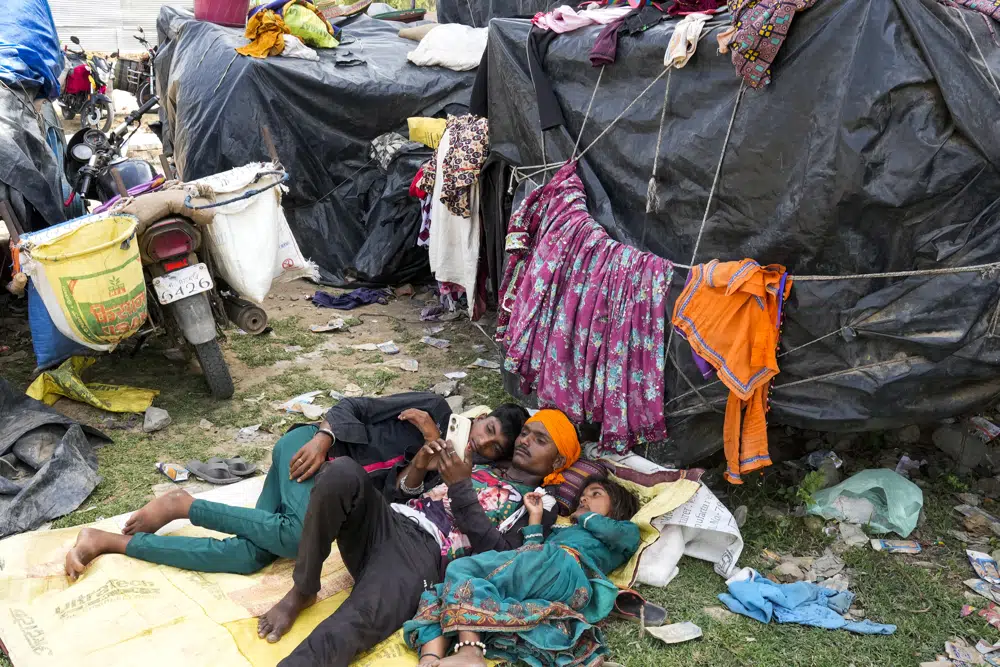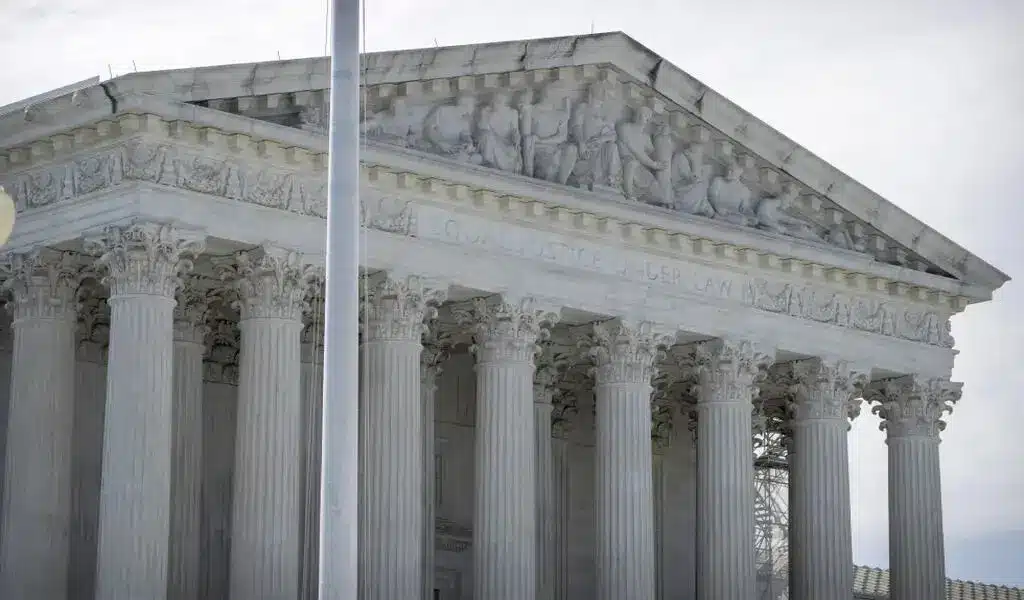News
People Dropping Dead from Heat Wave in India’s 2 Most Populous States
Officials announced that at least 96 people died in two of India’s most populous states during the last few days, as the country grappled with a blistering heat wave. The deaths occurred in the northern state of Uttar Pradesh and eastern Bihar, where authorities advised inhabitants over the age of 60 and those suffering from various illnesses to stay home during the day.
All 54 deaths in Uttar Pradesh were recorded in the Ballia area, around 300 kilometres (200 miles) southeast of Lucknow, the state capital. Authorities discovered that the majority of people who died were over 60 years old and had preexisting health issues that may have been aggravated by the extreme heat.
According to S. K. Yadav, a medical officer in Ballia, 300 patients have been hospitalised to the district hospital in the last three days for various ailments exacerbated by heat.
Due to the severity of the situation, authorities in Ballia cancelled leave applications and offered additional hospital beds in the emergency department to accommodate the surge of patients.

According to The Associated Press, the majority of the hospitalised patients are over the age of 60 and have symptoms such as high fever, vomiting, diarrhoea, breathing difficulties, and cardiac problems.
R.S. Pathak, a Ballia resident who lost his father on Saturday, claimed he saw an increase in the number of patients at the hospital’s emergency ward while attending to his father.
“Nothing like this has ever happened in Ballia.” “I’ve never seen so many people die as a result of the heat,” he remarked. “People are afraid to go out. The highways and markets are mostly vacant.”
Ballia, like the rest of central and eastern Uttar Pradesh, is currently experiencing terrible heat.
On Sunday, the maximum temperature in the district was 43 degrees Celsius (109 degrees Fahrenheit), which was five degrees more than the average range. The relative humidity was recorded at 25%, amplifying the heat’s effect.
Temperatures in the state are currently above normal, according to Atul Kumar Singh, a scientist with the India Meteorological Department. He went on to say that “no relief is expected in the next 24 hours.”
According to the IMD, heat wave conditions in portions of Uttar Pradesh will linger until June 19.
Brijesh Pathak, the state’s health minister, stated that an investigation into the deaths of “so many people” in Ballia had begun.

The blazing heat has consumed most of eastern Bihar, resulting in 42 deaths in the last two days. 35 of the deaths occurred at two hospitals in Patna, the state capital, where over 200 people were being treated for diarrhoea and vomiting.
On Saturday, the maximum temperature in Patna was 44.7 degrees Celsius (113 degrees Fahrenheit).
In most of India, the primary summer months — April, May, and June — are generally the hottest, before monsoon rains bring lower temperatures.
However, temperatures have risen during the last decade. During heat waves, the country typically experiences significant water shortages, with tens of millions of its 1.4 billion people without access to running water.
According to a study conducted by World Weather Attribution, an academic organisation that investigates the causes of high heat, a scorching heat wave that hit portions of South Asia in April was rendered at least 30 times more likely by climate change.
In April, the heat killed 13 people during a government function in Mumbai, India’s financial centre, prompting several governments to cancel all schools for a week.
World Health Organization: How to stay cool during a heat wave, you should:
At night, relocate to the coolest room in the house. If you can’t keep your house cool, spend 2-3 hours a day in a cool area (such as an air-conditioned public facility). Avoid going outside in the middle of the day.
If possible, avoid strenuous physical activities. If you must engage in vigorous activity, do so during the coolest period of the day, which is usually between 4:00 and 7:00 a.m. Keep to the shade.
Never leave children or pets in parked cars.
During a heatwave, take chilly showers or baths to keep your body cool and moisturized. To stay cool, you can also use cold packs and wraps, towels, sponging, and foot baths. Wear light, loose-fitting natural-fiber clothing.
Wear a wide-brimmed hat or cap and sunglasses if you walk outside. To reduce heat accumulation, use light bed linen and sheets and no pillows. Drink frequently, but avoid alcohol, coffee, and sugar. Eat smaller meals more frequently. Protein-rich foods should be avoided.
During a heatwave, if you feel dizzy, weak, worried, or have strong thirst and headache, it is preferable to get to a cool spot as quickly as possible and test your body temperature. To rehydrate, drink some water or fruit juice.
If you have painful muscular spasms (especially in the legs, arms, or belly), rest immediately and swallow electrolyte-containing oral rehydration treatments. If heat cramps linger more than an hour, get medical attention. Consult your doctor if you experience unexpected symptoms or if they continue.
If you or someone you care for has heated, dry skin, delirium, convulsions, or is unconscious, call a doctor or an ambulance right away. While waiting for assistance, move the person to a cool location, place him or her in a horizontal position, elevate legs and hips, remove clothing, and begin external cooling, such as placing cold packs on the neck, axillae, and groyne, fanning continuously, and spraying the skin with water at 25-30 °C. Take your body temperature. Give no acetylsalicylic acid or paracetamol. Place a sleeping person on his or her side.
During a heatwave, try to keep your living area cool. Check the room temperature between 08:00 and 10:00, 13:00 and after 22:00 at night. Ideally, the room temperature should be kept below 32 degrees Celsius during the day and below 24 degrees Celsius at night. This is especially crucial for newborns and those over the age of 60, as well as those with chronic medical disorders.
Open all of your windows and shutters at night and early morning when the outside temperature is cooler. Close the windows and shutters (if accessible) during the day, especially those facing the sun. Turn off all artificial lighting and electrical appliances. On windows that get morning or afternoon sun, hang shades, draperies, awnings, or louvres. To chill the air in the room, hang wet towels. It is worth noting that the humidity of the air rises at the same time.
If your home has air conditioning, close the doors and windows to preserve electricity that is not needed to keep you comfortable, ensuring that power remains available and reducing the possibility of a community-wide outage. Electric fans may provide relief, but they may not prevent heat-related sickness when the temperature is above 35 °C. It is critical to stay hydrated.

News
Google’s Search Dominance Is Unwinding, But Still Accounting 48% Search Revenue

Google is so closely associated with its key product that its name is a verb that signifies “search.” However, Google’s dominance in that sector is dwindling.
According to eMarketer, Google will lose control of the US search industry for the first time in decades next year.
Google will remain the dominant search player, accounting for 48% of American search advertising revenue. And, remarkably, Google is still increasing its sales in the field, despite being the dominating player in search since the early days of the George W. Bush administration. However, Amazon is growing at a quicker rate.
Google’s Search Dominance Is Unwinding
Amazon will hold over a quarter of US search ad dollars next year, rising to 27% by 2026, while Google will fall even more, according to eMarketer.
The Wall Street Journal was first to report on the forecast.
Lest you think you’ll have to switch to Bing or Yahoo, this isn’t the end of Google or anything really near.
Google is the fourth-most valued public firm in the world. Its market worth is $2.1 trillion, trailing just Apple, Microsoft, and the AI chip darling Nvidia. It also maintains its dominance in other industries, such as display advertisements, where it dominates alongside Facebook’s parent firm Meta, and video ads on YouTube.
To put those “other” firms in context, each is worth more than Delta Air Lines’ total market value. So, yeah, Google is not going anywhere.
Nonetheless, Google faces numerous dangers to its operations, particularly from antitrust regulators.
On Monday, a federal judge in San Francisco ruled that Google must open up its Google Play Store to competitors, dealing a significant blow to the firm in its long-running battle with Fortnite creator Epic Games. Google announced that it would appeal the verdict.
In August, a federal judge ruled that Google has an illegal monopoly on search. That verdict could lead to the dissolution of the company’s search operation. Another antitrust lawsuit filed last month accuses Google of abusing its dominance in the online advertising business.
Meanwhile, European regulators have compelled Google to follow tough new standards, which have resulted in multiple $1 billion-plus fines.

Pixa Bay
Google’s Search Dominance Is Unwinding
On top of that, the marketplace is becoming more difficult on its own.
TikTok, the fastest-growing social network, is expanding into the search market. And Amazon has accomplished something few other digital titans have done to date: it has established a habit.
When you want to buy anything, you usually go to Amazon, not Google. Amazon then buys adverts to push companies’ products to the top of your search results, increasing sales and earning Amazon a greater portion of the revenue. According to eMarketer, it is expected to generate $27.8 billion in search revenue in the United States next year, trailing only Google’s $62.9 billion total.
And then there’s AI, the technology that (supposedly) will change everything.
Why search in stilted language for “kendall jenner why bad bunny breakup” or “police moving violation driver rights no stop sign” when you can just ask OpenAI’s ChatGPT, “What’s going on with Kendall Jenner and Bad Bunny?” in “I need help fighting a moving violation involving a stop sign that wasn’t visible.” Google is working on exactly this technology with its Gemini product, but its success is far from guaranteed, especially with Apple collaborating with OpenAI and other businesses rapidly joining the market.
A Google spokeswoman referred to a blog post from last week in which the company unveiled ads in its AI overviews (the AI-generated text that appears at the top of search results). It’s Google’s way of expressing its ability to profit on a changing marketplace while retaining its business, even as its consumers steadily transition to ask-and-answer AI and away from search.

Google has long used a single catchphrase to defend itself against opponents who claim it is a monopoly abusing its power: competition is only a click away. Until recently, that seemed comically obtuse. Really? We are going to switch to Bing? Or Duck Duck Go? Give me a break.
But today, it feels more like reality.
Google is in no danger of disappearing. However, every highly dominating company faces some type of reckoning over time. GE, a Dow mainstay for more than a century, was broken up last year and is now a shell of its previous dominance. Sears declared bankruptcy in 2022 and is virtually out of business. US Steel, long the foundation of American manufacturing, is attempting to sell itself to a Japanese corporation.
SOURCE | CNN
News
2024 | Supreme Court Won’t Hear Appeal From Elon Musk’s X Platform Over Warrant In Trump Case

Washington — Trump Media, The Supreme Court announced Monday that it will not hear an appeal from social media platform X about a search warrant acquired by prosecutors in the election meddling case against former President Donald Trump.
The justices did not explain their rationale, and there were no recorded dissents.
The firm, which was known as Twitter before being purchased by billionaire Elon Musk, claims a nondisclosure order that prevented it from informing Trump about the warrant obtained by special counsel Jack Smith’s team violated its First Amendment rights.
The business also claims Trump should have had an opportunity to exercise executive privilege. If not reined in, the government may employ similar tactics to intercept additional privileged communications, their lawyers contended.
Supreme Court Won’t Hear Appeal From Elon Musk’s X Platform Over Warrant In Trump Case
Two neutral electronic privacy groups also joined in, urging the high court to hear the case on First Amendment grounds.
Prosecutors, however, claim that the corporation never shown that Trump utilized the account for official purposes, therefore executive privilege is not a problem. A lower court also determined that informing Trump could have compromised the current probe.

Trump utilized his Twitter account in the weeks preceding up to his supporters’ attack on the Capitol on January 6, 2021, to spread false assertions about the election, which prosecutors claim were intended to create doubt in the democratic process.
The indictment describes how Trump used his Twitter account to encourage his followers to travel to Washington on Jan. 6, pressuring Vice President Mike Pence to reject the certification, and falsely claiming that the Capitol crowd, which battered police officers and destroyed glass, was peaceful.
Supreme Court Won’t Hear Appeal From Elon Musk’s X Platform Over Warrant In Trump Case
That case is now moving forward following the Supreme Court’s verdict in July, which granted Trump full immunity from criminal prosecution as a former president.
The warrant arrived at Twitter amid quick changes implemented by Musk, who bought the company in 2022 and has since cut off most of its workforce, including those dedicated to combating disinformation and hate speech.
SOURCE | AP
News
The Supreme Court Turns Down Biden’s Government Appeal in a Texas Emergency Abortion Matter.

(VOR News) – A ruling that prohibits emergency abortions that contravene the Supreme Court law in the state of Texas, which has one of the most stringent abortion restrictions in the country, has been upheld by the Supreme Court of the United States. The United States Supreme Court upheld this decision.
The justices did not provide any specifics regarding the underlying reasons for their decision to uphold an order from a lower court that declared hospitals cannot be legally obligated to administer abortions if doing so would violate the law in the state of Texas.
Institutions are not required to perform abortions, as stipulated in the decree. The common populace did not investigate any opposing viewpoints. The decision was made just weeks before a presidential election that brought abortion to the forefront of the political agenda.
This decision follows the 2022 Supreme Court ruling that ended abortion nationwide.
In response to a request from the administration of Vice President Joe Biden to overturn the lower court’s decision, the justices expressed their disapproval.
The government contends that hospitals are obligated to perform abortions in compliance with federal legislation when the health or life of an expectant patient is in an exceedingly precarious condition.
This is the case in regions where the procedure is prohibited. The difficulty hospitals in Texas and other states are experiencing in determining whether or not routine care could be in violation of stringent state laws that prohibit abortion has resulted in an increase in the number of complaints concerning pregnant women who are experiencing medical distress being turned away from emergency rooms.
The administration cited the Supreme Court’s ruling in a case that bore a striking resemblance to the one that was presented to it in Idaho at the beginning of the year. The justices took a limited decision in that case to allow the continuation of emergency abortions without interruption while a lawsuit was still being heard.
In contrast, Texas has been a vocal proponent of the injunction’s continued enforcement. Texas has argued that its circumstances are distinct from those of Idaho, as the state does have an exemption for situations that pose a significant hazard to the health of an expectant patient.
According to the state, the discrepancy is the result of this exemption. The state of Idaho had a provision that safeguarded a woman’s life when the issue was first broached; however, it did not include protection for her health.
Certified medical practitioners are not obligated to wait until a woman’s life is in imminent peril before they are legally permitted to perform an abortion, as determined by the state supreme court.
The state of Texas highlighted this to the Supreme Court.
Nevertheless, medical professionals have criticized the Texas statute as being perilously ambiguous, and a medical board has declined to provide a list of all the disorders that are eligible for an exception. Furthermore, the statute has been criticized for its hazardous ambiguity.
For an extended period, termination of pregnancies has been a standard procedure in medical treatment for individuals who have been experiencing significant issues. It is implemented in this manner to prevent catastrophic outcomes, such as sepsis, organ failure, and other severe scenarios.
Nevertheless, medical professionals and hospitals in Texas and other states with strict abortion laws have noted that it is uncertain whether or not these terminations could be in violation of abortion prohibitions that include the possibility of a prison sentence. This is the case in regions where abortion prohibitions are exceedingly restrictive.
Following the Supreme Court’s decision to overturn Roe v. Wade, which resulted in restrictions on the rights of women to have abortions in several Republican-ruled states, the Texas case was revisited in 2022.
As per the orders that were disclosed by the administration of Vice President Joe Biden, hospitals are still required to provide abortions in cases that are classified as dire emergency.
As stipulated in a piece of health care legislation, the majority of hospitals are obligated to provide medical assistance to patients who are experiencing medical distress. This is in accordance with the law.
The state of Texas maintained that hospitals should not be obligated to provide abortions throughout the litigation, as doing so would violate the state’s constitutional prohibition on abortions. In its January judgment, the 5th United States Circuit Court of Appeals concurred with the state and acknowledged that the administration had exceeded its authority.
SOURCE: AP
SEE ALSO:
Could Last-Minute Surprises Derail Kamala Harris’ Campaign? “Nostradamus” Explains the US Poll.
-

 News4 years ago
News4 years agoLet’s Know About Ultra High Net Worth Individual
-
Entertainment2 years ago
Mabelle Prior: The Voice of Hope, Resilience, and Diversity Inspiring Generations
-
News11 years ago
Enviromental Groups Tell Mekong Leaders Lao Dam Evaluation Process Flawed
-

 Health4 years ago
Health4 years agoHow Much Ivermectin Should You Take?
-

 Tech3 years ago
Tech3 years agoTop Forex Brokers of 2023: Reviews and Analysis for Successful Trading
-

 Lifestyles3 years ago
Lifestyles3 years agoAries Soulmate Signs
-

 Entertainment3 years ago
Entertainment3 years agoWhat Should I Do If Disney Plus Keeps Logging Me Out of TV?
-

 Health3 years ago
Health3 years agoCan I Buy Ivermectin Without A Prescription in the USA?



